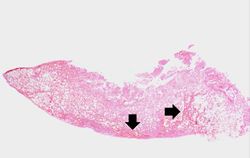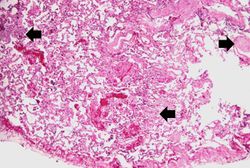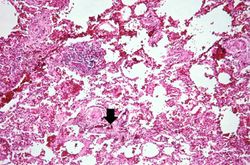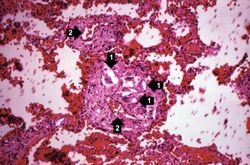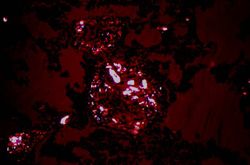Difference between revisions of "IPLab:Lab 3:Foreign Body Granuloma"
Seung Park (talk | contribs) |
Seung Park (talk | contribs) |
||
| Line 10: | Line 10: | ||
File:IPLab3ForeignBodyGranuloma5.jpg|This is a fully-polarized view of lung showing numerous birefringent particles. | File:IPLab3ForeignBodyGranuloma5.jpg|This is a fully-polarized view of lung showing numerous birefringent particles. | ||
</gallery> | </gallery> | ||
| + | |||
| + | == Study Questions == | ||
| + | |||
| + | * <spoiler text="Compare and contrast the tissue reactions to carbon (anthracosis), talc, and silica. What factors are important in the pathogenesis of tissue injury due to these foreign materials?">Carbon is relatively inert and leads to little if any tissue damage. | ||
| + | |||
| + | Talc results in foreign body granulomas but these lesions are mild. | ||
| + | |||
| + | Silica can lead to severe fibrosis of tissues, especially the lung. | ||
| + | |||
| + | Factors important in tissue injury include: | ||
| + | * size of particles (for airborne particles the small size lets them get deep into the lung), | ||
| + | * solubility of material, | ||
| + | * cytotoxicity of material (e.g. silica reacts with free radicals and other chemical groups to cause membrane damage), and finally | ||
| + | * whether the materials can be phagocytosed and removed from the body or whether they damage leukocytes and cause the release of inflammatory mediators.</spoiler> | ||
| + | * <spoiler text="What are the birefringent particles seen in the nodules adjacent to the vessels and how did they get there?">The material is talc, which is often used to "cut" street drugs. Intravenous injection of talc leads to some talc being deposited in tissues and initiating an inflammatory response.</spoiler> | ||
{{IPLab 3}} | {{IPLab 3}} | ||
[[Category:IPLab:Lab 3]] | [[Category:IPLab:Lab 3]] | ||
Revision as of 05:00, 19 August 2013
Clinical Summary[edit]
This 21-year-old black male suffered a gunshot wound to his right chest. A thoracotomy revealed multiple bleeding points in the middle and lower lobe of the right lung and significant hemorrhage from an intercostal artery. A portion of the right middle lobe was removed. The patient's post-operative course was complicated by Gram-negative pneumonia and significant neurologic dysfunction, apparently the result of emboli from iliofemoral venous thrombosis. All were treated without sequelae.
Images[edit]
Study Questions[edit]
A thoracotomy is a surgical procedure in which an opening is made in the chest wall.
In alcoholics, aspiration pneumonia is common--bacteria enter the lung via aspiration of gastric contents.
Plural of embolus. An embolus is something that blocks the blood flow in a blood vessel. It may be a gas bubble, a blood clot, a fat globule, a mass of bacteria, or other foreign body. It usually forms somewhere else and travels through the circulatory system until it gets stuck.
Thrombosis occurring in the deep veins of the legs is a common sequela seen post-operatively.
